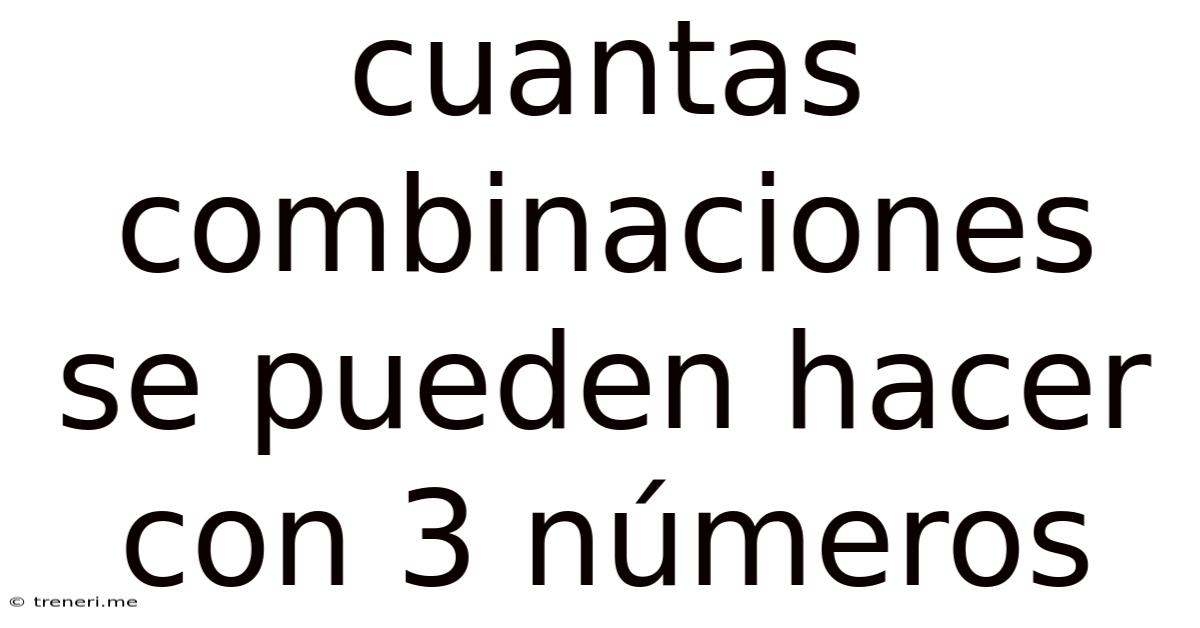Cuantas Combinaciones Se Pueden Hacer Con 3 Números
Treneri
May 10, 2025 · 4 min read

Table of Contents
How Many Combinations Can You Make With 3 Numbers? A Deep Dive into Permutations and Combinations
The question, "How many combinations can you make with 3 numbers?" seems simple at first glance. However, the answer depends critically on whether the order of the numbers matters (permutations) and whether repetition of numbers is allowed. This article will explore all these scenarios, providing a comprehensive understanding of permutations and combinations, and equipping you with the tools to calculate combinations for various scenarios.
Understanding Permutations and Combinations
Before diving into the specifics of 3 numbers, let's clarify the fundamental difference between permutations and combinations. This distinction is crucial for accurately calculating the number of possibilities.
-
Permutations: Permutations are arrangements where the order of the elements matters. For example, 123 is considered a different permutation from 321, even though they use the same numbers.
-
Combinations: Combinations are selections where the order of the elements does not matter. 123 is considered the same combination as 321.
Scenario 1: Permutations with Repetition Allowed
Let's assume we have a set of digits from 0 to 9, and we want to form 3-digit numbers where repetition is permitted (e.g., 111, 223, 987 are all valid).
In this case, for each position in the 3-digit number, we have 10 choices (0-9). Therefore, the total number of permutations is:
10 choices (for the first digit) * 10 choices (for the second digit) * 10 choices (for the third digit) = 1000
Therefore, there are 1000 possible 3-digit numbers when repetition is allowed.
Scenario 2: Permutations without Repetition
Now, let's consider the same problem, but repetition is not allowed. Once a digit is used, it cannot be used again.
For the first digit, we have 10 choices. For the second digit, we have only 9 choices left (since we can't repeat the first digit). For the third digit, we have 8 choices remaining.
The total number of permutations is:
10 * 9 * 8 = 720
Therefore, there are 720 possible 3-digit numbers when repetition is not allowed.
Scenario 3: Combinations with Repetition Allowed
This scenario gets slightly more complex. We're interested in the number of unique sets of 3 digits, where repetition is allowed, and the order doesn't matter. For example, {1,1,2} is considered the same as {1,2,1} and {2,1,1}.
This type of problem is solved using the stars and bars method or combinations with repetition formula. The formula is:
(n + k - 1)! / (k! * (n - 1)!)
where 'n' is the number of choices (10 in our case, digits 0-9), and 'k' is the number of selections (3 in our case).
Plugging in the values:
(10 + 3 - 1)! / (3! * (10 - 1)!) = 12! / (3! * 9!) = (12 * 11 * 10) / (3 * 2 * 1) = 220
Therefore, there are 220 unique combinations of 3 digits when repetition is allowed and order doesn't matter.
Scenario 4: Combinations without Repetition
This is the simplest case. We want to choose 3 distinct digits from 0 to 9, and the order doesn't matter. This is a classic combination problem.
The formula for combinations without repetition is:
n! / (k! * (n - k)!)
Where 'n' is the number of items to choose from (10 digits), and 'k' is the number of items we're choosing (3 digits).
10! / (3! * 7!) = (10 * 9 * 8) / (3 * 2 * 1) = 120
Therefore, there are 120 unique combinations of 3 distinct digits when repetition is not allowed.
Expanding the Concepts: Beyond 3 Numbers
The principles discussed above can be easily extended to scenarios involving more than 3 numbers. The formulas for permutations and combinations can be generalized:
-
Permutations with Repetition: n<sup>k</sup> (where 'n' is the number of choices and 'k' is the number of selections)
-
Permutations without Repetition: n! / (n - k)!
-
Combinations with Repetition: (n + k - 1)! / (k! * (n - 1)!)
-
Combinations without Repetition: n! / (k! * (n - k)!)
Practical Applications
Understanding permutations and combinations has numerous practical applications across various fields:
-
Password Security: Calculating the number of possible password combinations helps assess the strength of a password system.
-
Lottery Probability: Determining the probability of winning a lottery involves calculating the number of possible combinations.
-
Data Analysis: In statistics, combinations are used in calculating probabilities and analyzing datasets.
-
Genetics: Combinations and permutations play a vital role in understanding genetic possibilities.
Conclusion
The seemingly simple question of "How many combinations can you make with 3 numbers?" opens a door to a rich mathematical field. By understanding the nuances of permutations and combinations, and the difference between scenarios with and without repetition, we can accurately calculate the number of possibilities in various contexts. This knowledge is valuable in diverse fields, from assessing security risks to understanding probability and statistical analyses. Mastering these concepts provides a powerful tool for problem-solving and critical thinking. Remember to always carefully consider whether order matters and whether repetition is allowed to choose the correct formula and arrive at the accurate solution.
Latest Posts
Latest Posts
-
Cuanto Es 90 Cm En Pies
May 10, 2025
-
50 Miles Per Gallon To Kmpl
May 10, 2025
-
What Is The Least Common Multiple Of 24 And 8
May 10, 2025
-
Is A 15 Out Of 20 Good
May 10, 2025
-
How Many Hours Is 3 30 To 9 30
May 10, 2025
Related Post
Thank you for visiting our website which covers about Cuantas Combinaciones Se Pueden Hacer Con 3 Números . We hope the information provided has been useful to you. Feel free to contact us if you have any questions or need further assistance. See you next time and don't miss to bookmark.